

A statute of limitations is a legal time limit that determines how long someone has to file a lawsuit or claim for a specific type of case. When it comes to malpractice claims, there is typically a statute of limitations in place that dictates the amount of time a patient has to bring a lawsuit against a healthcare provider for alleged malpractice.
The purpose of having a statute of limitations for malpractice claims is to ensure that cases are brought forward in a timely manner while evidence and witness recollections are still fresh. It also provides some level of certainty and finality for both the plaintiff and defendant, as cases cannot be brought indefinitely into the future.
In most states, the statute of limitations for medical malpractice claims ranges from 2-6 years, with some variations depending on the specific circumstances of the case. It's important for potential plaintiffs to be aware of these time limits and take action promptly if they believe they have been harmed by medical negligence.
Overall, understanding the statute of limitations for malpractice claims is crucial for anyone who may have been affected by medical error. By being aware of these legal deadlines, individuals can protect their rights and seek justice within the appropriate timeframe.
When it comes to filing a malpractice claim, it's important to be aware of the time limits set by each state. These time limits, known as statutes of limitations, dictate how long a patient has to file a claim against a healthcare provider for alleged malpractice.
In general, statutes of limitations for malpractice claims range from 1-3 years in most states. However, it's crucial to check the specific laws in your state as they can vary significantly. For example, some states have shorter time limits for claims involving minors or cases of fraud.
Failing to file a malpractice claim within the statute of limitations can result in the case being dismissed by the court. This means that even if you have a legitimate claim, you may not be able to seek compensation if you miss the deadline.
To ensure that you don't miss out on your chance to seek justice for medical malpractice, it's essential to familiarize yourself with the time limits in your state and take action promptly if you believe you have been a victim of negligence. Consulting with a legal professional who specializes in medical malpractice can help you understand your rights and navigate the complexities of filing a claim within the allotted time frame.

If you believe that you have been a victim of medical malpractice in Oakland, it is important to take immediate action to protect your rights and seek justice for any harm that has been done to you.. Medical malpractice occurs when a healthcare provider fails to meet the standard of care expected in their profession, resulting in harm or injury to the patient. The first step you should take if you suspect medical malpractice is to gather all relevant information about your treatment, including medical records, prescriptions, and any correspondence with your healthcare provider.
Posted by on 2024-12-02

Medical malpractice can have devastating consequences for patients and their families.. When healthcare providers fail to meet the standard of care expected of them, it can lead to serious injuries or even death.
Posted by on 2024-12-02

Filing a medical malpractice claim in Oakland can be a complex and daunting process.. It is important to understand the necessary steps involved in order to have the best chance of success in your case. The first step in filing a medical malpractice claim is to gather all relevant medical records and documentation related to the incident.
Posted by on 2024-12-02

If you or a loved one has been a victim of medical malpractice in Oakland, you may be feeling overwhelmed and uncertain about what steps to take next.. It can be a confusing and emotional time, but it's important to remember that you have rights and options available to you. One crucial step in seeking justice for medical malpractice is finding expert legal guidance to help you navigate the complexities of the legal system.
Posted by on 2024-12-02
The statute of limitations for malpractice claims refers to the time limit within which a patient can file a lawsuit against a healthcare provider for negligence or harm caused during medical treatment. However, there are several factors that can affect this timeframe and potentially extend or shorten the deadline for filing a claim.
One of the main factors that can impact the statute of limitations is the state in which the malpractice occurred. Each state has its own laws governing medical malpractice claims, including the time limit for filing a lawsuit. Some states have relatively short statutes of limitations, while others may allow patients more time to pursue legal action.
Another factor that can influence the statute of limitations is when the patient discovers or should have reasonably discovered their injury. In some cases, patients may not realize they have been harmed by medical negligence until long after the incident occurred. In these situations, some states allow for an extended period from the date of discovery to file a malpractice claim.
Additionally, certain circumstances such as age or mental capacity can also impact the statute of limitations. For example, minors who are injured due to medical malpractice may have an extended timeframe in which to file a claim once they reach adulthood. Similarly, individuals with disabilities that prevent them from understanding their rights may be granted additional time to pursue legal action.
Overall, it is important for patients who believe they have been harmed by medical negligence to be aware of the factors that can affect the statute of limitations for malpractice claims. Consulting with a knowledgeable attorney can help ensure that their rights are protected and that they take appropriate action within the required timeframe.

Understanding and adhering to statute of limitations deadlines is crucial when it comes to malpractice claims. These deadlines are put in place to ensure that justice is served in a timely manner, and failing to meet them can result in losing the opportunity to seek compensation for damages.
By understanding the statute of limitations for malpractice claims, individuals can effectively protect their rights and hold negligent parties accountable for their actions. It is important to be aware of these deadlines so that you can take appropriate action within the specified time frame.
Adhering to statute of limitations deadlines also helps ensure that evidence is preserved and witnesses are available to support your claim. Failing to file a claim within the required timeframe can result in the loss of crucial evidence and make it more difficult to prove your case.
In conclusion, understanding and adhering to statute of limitations deadlines for malpractice claims is essential for ensuring that justice is served. By staying informed about these deadlines and taking prompt action when necessary, individuals can protect their rights and seek compensation for any damages they have suffered due to medical negligence.
Missing the deadline to file a malpractice claim can have serious consequences for individuals seeking justice for medical negligence. The statute of limitations for malpractice claims varies by state, but in general, it is typically between one to three years from the date of the injury or discovery of the malpractice.
If you fail to file your claim within the specified time frame, you may lose your right to pursue legal action against the negligent party. This means that you will not be able to seek compensation for any damages incurred as a result of the malpractice, such as medical expenses, lost wages, and pain and suffering.
Furthermore, missing the deadline can also prevent you from holding healthcare providers accountable for their actions and potentially preventing similar incidents from occurring in the future. By not filing a claim in a timely manner, you may be allowing negligent behavior to go unchecked and putting other patients at risk.
It is important to be aware of the statute of limitations for malpractice claims in your state and take prompt action if you believe you have been a victim of medical negligence. Consulting with an experienced attorney who specializes in malpractice cases can help ensure that your rights are protected and that you receive the compensation you deserve. Remember, time is of the essence when it comes to filing a malpractice claim - don't let it slip away.
If the statute of limitations has expired for malpractice claims, there may still be options available to pursue justice. While the time limit for filing a lawsuit may have passed, there are alternative routes that can be explored.
One option is to seek arbitration or mediation to resolve the dispute outside of the court system. This can be a more cost-effective and timely way to address the issue, allowing both parties to come to a mutually agreeable resolution.
Another option is to file a complaint with the appropriate licensing board or regulatory agency. While this may not result in financial compensation, it can lead to disciplinary action against the healthcare provider, ensuring that they are held accountable for their actions.
Additionally, it may be possible to pursue a claim based on fraud or intentional misconduct, which could have a longer statute of limitations than a standard malpractice claim. Consulting with an attorney who specializes in medical malpractice law can help determine if this avenue is viable.
In any case, it is important to act quickly and seek legal advice as soon as possible if you believe you have been a victim of malpractice. While the statute of limitations may have expired for traditional claims, there may still be options available to seek justice and hold negligent healthcare providers accountable for their actions.
Oakland | |
|---|---|
Skyline of Downtown Oakland, with the San Francisco Bay in the background Eastern span of the Bay Bridge | |
| Nickname(s): "Oaktown",[1] "The Town" | |
| Motto: "Love life"[2] | |
 Location in Alameda County and the U.S. state of California | |
| Coordinates: 37°48′16″N 122°16′15″W / 37.80444°N 122.27083°W | |
| Country | United States |
| State | California |
| County | Alameda |
| Incorporated | May 4, 1852[3][4] |
| Named for | The large oak forest that originally covered the area[5] |
| Government | |
| • Type | Strong mayor[6] |
| • Body | Oakland City Council |
| • Mayor | Sheng Thao (D)[7] |
| • Vice Mayor | Rebecca Kaplan (D) |
| • State senator | Tim Grayson (D)[8] |
| • Assemblymembers | Buffy Wicks (D) and Mia Bonta (D)[9] |
| • U. S. rep. | Barbara Lee (D)[10] |
| Area | |
• Total | 78.03 sq mi (202.10 km2) |
| • Land | 55.93 sq mi (144.86 km2) |
| • Water | 22.10 sq mi (57.24 km2) |
| Elevation | 43 ft (13 m) |
| Population | |
• Total | 440,646 |
| • Rank | 1st in Alameda County 8th in California 45th in the United States |
| • Density | 7,878.53/sq mi (3,041.87/km2) |
| Demonym | Oaklander |
| Time zone | UTC−08:00 (PST) |
| • Summer (DST) | UTC−07:00 (PDT) |
| ZIP Codes | 94601–94615, 94617-94624, 94649, 94659–94662, 94666[14] |
| Area codes | 510/341 |
| FIPS code | 06-53000 |
| GNIS feature IDs | 277566, 2411292 |
| Website | www [15][16][17] |
Oakland is a city in the East Bay region of the San Francisco Bay Area in the U.S. state of California. It is the county seat and most populous city in Alameda County, with a population of 440,646 in 2020.[13] A major West Coast port, Oakland is the most populous city in the East Bay, the third most populous city in the Bay Area, and the eighth most populous city in California. It serves as the Bay Area's trade center: the Port of Oakland is the busiest port in Northern California, and the fifth- or sixth-busiest in the United States.[18] A charter city,[19] Oakland was incorporated on May 4, 1852, in the wake of the state's increasing population due to the California gold rush.[4]
Oakland's territory covers what was once a mosaic of California coastal terrace prairie, oak woodland, and north coastal scrub.[20] In the late 18th century, it became part of a large rancho grant in the colony of New Spain, and was known for its plentiful oak tree stands. Its land served as a resource when its hillside oak and redwood timber were logged to build San Francisco.[20] The fertile flatland soils helped it become a prolific agricultural region. In the 1850s, what became the first campus of the University of California was founded in Oakland, and Oakland was selected as the western terminal of the Transcontinental Railroad in 1869.[21] The following year, Oakland's Lake Merritt became the United States' first officially designated wildlife refuge, now a National Historic Landmark. Following the catastrophic 1906 San Francisco earthquake, many San Francisco citizens moved to Oakland, enlarging the population, increasing its housing stock, and improving its infrastructure. It continued to grow in the 20th century with its port, shipyards, and manufacturing industry. In the 21st century, between 2019 and 2023, after the city and county refused requests for hundreds of millions of dollars in benefits to the privately owned teams, Oakland lost three teams of the major North American sports leagues within a span of five years.[22][23]
The earliest known inhabitants of the area were the Huchiun natives, who lived there for thousands of years. The Huchiun belonged to a linguistic grouping later called the Ohlone (a Miwok word meaning "western people").[24] In Oakland, they were concentrated around Lake Merritt and Temescal Creek, a stream that enters the San Francisco Bay at Emeryville.
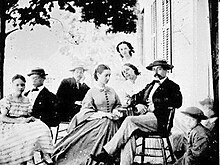
In 1772, the area that later became Oakland was colonized, along with the rest of California, by Spanish settlers for the king of Spain. In the early 19th century, the Spanish crown granted the East Bay area to Luis María Peralta for his Rancho San Antonio. The grant was confirmed by the successor Mexican republic upon its independence from Spain.[25] Upon his death in 1842, Peralta divided his land among his four sons. Most of Oakland was within the shares given to Antonio Maria and Vicente.[26] The portion of the parcel that is now Oakland was called Encinar (misrendered at an early date and carried forward as "encinal") – Spanish for "oak grove" – due to the large oak forest that covered the area, which eventually led to the city's name.[5]
According to Stanford University historian Albert Camarillo, the Peralta family struggled to keep their land after the incorporation of California into the United States after the Mexican–American War. Camarillo claims the family was the victim of targeted racial violence. He writes in Chicanos in California, "They lost everything when squatters cut down their fruit trees, killed their cattle, destroyed their buildings, and even fenced off the roads leading to the rancho. Especially insidious were the actions of attorney Horace Carpentier, who tricked Vicente Peralta into signing a 'lease' which turned out to be a mortgage against the 19,000-acre rancho. The lands became Carpentier's when Peralta refused to repay the loan he believed was fraudulently incurred. The Peraltas had no choice but to abandon the homesite they had occupied for two generations."[27]

In 1851, three men—Horace Carpentier, Edson Adams, and Andrew Moon—began developing what is now downtown Oakland.[28] In 1852, the Town of Oakland was incorporated by the state legislature.[29] During this time, Oakland had 75–100 inhabitants, two hotels, a wharf, two warehouses, and only cattle trails. Two years later, on March 25, 1854, Oakland re-incorporated as the City of Oakland.[30] Horace Carpentier was elected the first mayor, though a scandal ended his mayorship in less than a year.[31] In 1853, a preparatory academy was founded in Oakland that soon became the College of California, and in 1869, the first campus of the University of California. The university moved just north to Berkeley in the 1870s.[32]
During the 1850s, just as gold was discovered in California, Oakland started growing and further developing because land was becoming too expensive in San Francisco.[33] People in China were struggling financially as a result of the First Opium War, the Second Opium War, and the Taiping Rebellion, so they began migrating to Oakland, many of whom were recruited to work on railroads. However, the Chinese struggled to settle because they were discriminated against by the white community and their living quarters were burned down on several occasions.[34][page needed]
The city and its environs quickly grew with the railroads, becoming a major rail terminal in the late 1860s and 1870s. In 1868, the Central Pacific constructed the Oakland Long Wharf at Oakland Point, the site of today's Port of Oakland.[35]
A number of horsecar and cable car lines were constructed in Oakland during the latter half of the 19th century. The first electric streetcar set out from Oakland to Berkeley in 1891, and other lines were converted and added over the course of the 1890s. The various streetcar companies operating in Oakland were acquired by Francis "Borax" Smith and consolidated into what eventually became known as the Key System, the predecessor of today's publicly owned AC Transit.
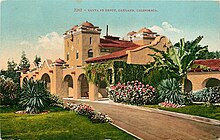
Oakland was one of the worst affected cities in California that was impacted by the San Francisco plague of 1900–1904. Quarantine measures were set in place at the Oakland ports requiring the authorities at the port to inspect the arriving vessels for the presence of infected rats.[36] Quarantine authorities at these ports inspected over a thousand vessels per year for plague and yellow fever. By 1908, over 5,000 people were detained in quarantine.[37] Hunters were sent to poison the affected areas in Oakland and shoot the squirrels, but the eradication work was limited in its range because the State Board of Health and the United States Public Health Service were only allotted about $60,000 a year to eradicate the disease. During this period Oakland did not have sufficient health facilities, so some of the infected patients were treated at home.[38]
The State Board of Health along with Oakland also advised physicians to promptly report any cases of infected patients.[39] Yet, in 1919 it still resulted in a small epidemic of Pneumonic plague which killed a dozen people in Oakland.[39] This started when a man went hunting in Contra Costa Valley and killed a squirrel. After eating the squirrel, he fell ill four days later and another household member contracted the plague. This in turn was passed on either directly or indirectly to about a dozen others.[40] The officials in Oakland acted quickly by issuing death certificates to monitor the spread of plague.[39]

At the time of incorporation in 1852, Oakland had consisted of the territory that lay south of today's major intersection of San Pablo Avenue, Broadway, and Fourteenth Street. The city gradually annexed farmlands and settlements to the east and the north. Oakland's rise to industrial prominence, and its subsequent need for a seaport, led to the digging of a shipping and tidal channel in 1902. This resulted in the nearby town of Alameda being made an island. In 1906, the city's population doubled with refugees made homeless after the 1906 San Francisco earthquake and fire.
In 1908, the lawyer, former miner, and newspaper owner Homer Wood (1880–1976) suggested to his friend Frank Bilger of Blake and Bilger Rock Quarry and Paving Company that he organize a gathering to establish a Rotary Club east of the bay. On November 27, 1908, Homer took a ferry across the bay in a driving rainstorm and met for lunch with Frank and twenty three other businessmen at the Hotel Metropole at 13th and Jefferson. This gathering became the first meeting of the Tri-City Rotary Club, renamed in 1911 The Rotary Club of Oakland, the third Rotary Club in the world. This group established the tradition of weekly meetings, something most clubs worldwide follow today.[41]
In 1917, General Motors opened an automobile factory in East Oakland called Oakland Assembly. It produced Chevrolet cars and then GMC trucks until 1963, when it was moved to Fremont in southern Alameda County.[42] Also in 1916, the Fageol Motor Company chose East Oakland for their first factory, manufacturing farming tractors from 1918 to 1923.[43][44] By 1920, Oakland was the home of numerous manufacturing industries, including metals, canneries, bakeries, internal combustion engines, automobiles, and shipbuilding.[45] By 1929, when Chrysler expanded with a new plant there, Oakland had become known as the "Detroit of the West," referring to the major auto manufacturing center in Michigan.[46]
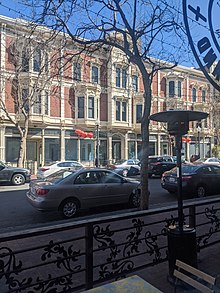
Oakland expanded during the 1920s, as its population expanded with factory workers. Approximately 13,000 homes were built in the 3 years between 1921 and 1924,[47] more than during the 13 years between 1907 and 1920.[48] Many of the large downtown office buildings, apartment buildings, and single-family houses still standing in Oakland were built during the 1920s; they reflect the architectural styles of the time.
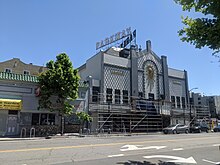

Russell Clifford Durant established Durant Field at 82nd Avenue and East 14th Street in 1916.[49] The first transcontinental airmail flight finished its journey at Durant Field on August 9, 1920, flown by Army Capt. Eddie Rickenbacker and Navy Lt. Bert Acosta.[50] Durant Field was often called Oakland Airport, though the current Oakland International Airport was soon established four miles (6.4 km) to the southwest.[51]
During World War II, the East Bay Area was home to many war-related industries. Oakland's Moore Dry Dock Company expanded its shipbuilding capabilities and built over 100 ships. Valued at $100 million in 1943, Oakland's canning industry was its second-most-valuable war contribution after shipbuilding. The largest canneries were in the Fruitvale District, and included the Josiah Lusk Canning Company, the Oakland Preserving Company (which started the Del Monte brand), and the California Packing Company.[52]
President Franklin D. Roosevelt called on defense industries with government contracts to integrate their workforces and provide opportunities for all Americans. Tens of thousands of laborers came from around the country, especially poor whites and blacks from the Deep South: Alabama, Arkansas, Georgia, Louisiana, Mississippi, South Carolina, and Texas, as well as Missouri and Tennessee. Henry J. Kaiser's representatives recruited sharecroppers and tenant farmers from rural areas to work in his shipyards. African Americans were part of the Great Migration by which five million persons left the South, mostly for the West, from 1940 to 1970. White migrants from the Jim Crow South carried their racial attitudes, causing tensions to rise among black and white workers competing for better-paying jobs in the Bay Area. The racial harmony Oakland African-Americans had been accustomed to prior to the war evaporated.[53] Also migrating to the area during this time were many Mexican Americans from southwestern states such as New Mexico, Texas, and Colorado. Many worked for the Southern Pacific Railroad, at its major rail yard in West Oakland. Their young men encountered hostility and discrimination by Armed Forces personnel, and tensions broke out in "zoot suit riots" in downtown Oakland in 1943 in the wake of a major disturbance in Los Angeles that year.[54]
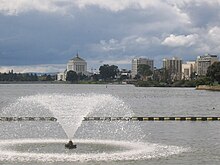
In 1946, National City Lines (NCL), a General Motors holding company, acquired 64% of Key System stock; during the next several years NCL engaged in the conspiratorial dissolution of Oakland's electric streetcar system. The city's expensive electric streetcar fleet was converted to cheaper diesel buses.[55] The state Legislature created the Alameda and Contra Costa Transit District in 1955, which operates today as AC Transit, the third-largest bus-only transit system in the nation.[56]
After the war, as Oakland's shipbuilding industry declined and the automobile industry went through restructuring, many jobs were lost.[citation needed] In addition, labor unrest increased as workers struggled to protect their livelihoods. Oakland was the center of a general strike during the first week of December 1946, one of six cities across the country that had such a strike after World War II.[57]
The Mary's First and Last Chance in Oakland was a lesbian bar, once the focus of the 1950s California Supreme Court lawsuit Vallerga v. Dept. Alcoholic Bev. Control, when the bar challenged a state law for the right to serve gay patrons and won in 1959.[58][59]
In 1960, Kaiser Corporation opened its new headquarters; it was the largest skyscraper in Oakland, as well as "the largest office tower west of Chicago" up to that time.[60] In the postwar period, suburban development increased around Oakland, and wealthier residents moved to new housing. Despite the major increases in the number and proportion of African Americans in the city, in 1966 only 16 of the city's 661 police officers were black. Tensions between the black community and the largely white police force were high, as expectations during the civil rights era increased to gain social justice and equality before the law. Police abuse of blacks was common.[61][62]
Students Huey Newton and Bobby Seale founded the Black Panther Party at Merritt College (then located at a former high school on Grove Street, now occupied by Children's Hospital Oakland Research Institute), which emphasized Black nationalism, advocated armed self-defense against police, and was involved in several incidents that ended in the deaths of police officers and other Black Panther members. Among their social programs were feeding children and providing other services to the needy.[63]
As in many other American cities during the 1980s, crack cocaine became a serious problem in Oakland. Drug dealing in general, and the dealing of crack cocaine in particular, resulted in elevated rates of violent crime, causing Oakland to consistently be listed as one of America's most crime-ridden cities.[64]
In 1980, Oakland's Black population reached its 20th-century peak at approximately 47% of the overall city population.[65]
The 6.9 Mw Loma Prieta earthquake occurred on October 17, 1989. The rupture was related to the San Andreas fault system and affected the entire San Francisco Bay Area with a maximum Mercalli intensity of IX (Violent). Many structures in Oakland were badly damaged including the double-decker portion of Interstate 880 that collapsed. The eastern span of the San Francisco–Oakland Bay Bridge also sustained damage and was closed to traffic for one month.
On October 20, 1991, a massive firestorm swept down from the Berkeley/Oakland hills above the Caldecott Tunnel. Twenty-five people were killed, 150 people were injured, and nearly 4,000 homes destroyed. With the loss of life and an estimated economic loss of US$1.5 billion, this was the worst urban firestorm in American history, until 2017.[66][67]
During the mid-1990s, Oakland's economy began to recover as it transitioned to new types of jobs. In addition, the city participated in large development and urban renewal projects, concentrated especially in the downtown area, at the Port of Oakland, and at the Oakland International Airport.[68]

After his 1999 inauguration, Oakland Mayor Jerry Brown continued his predecessor Elihu Harris' public policy of supporting downtown housing development in the area defined as the Central Business District in Oakland's 1998 General Plan.[69] Brown's plan and other redevelopment projects were controversial due to potential rent increases and gentrification, which would displace lower-income residents from downtown Oakland into outlying neighborhoods and cities.[70]
Due to allegations of misconduct by the Oakland Police Department, the City of Oakland has paid claims for a total of US$57 million during the 2001–2011 timeframe to plaintiffs claiming police abuse; this is the largest sum paid by any city in California.[71] On October 10, 2011, protesters and civic activists began "Occupy Oakland" demonstrations at Frank Ogawa Plaza in Downtown Oakland.[72][73]
African-Americans dropped to 28% of Oakland's population in 2010, from nearly half in 1980, due to fast-rising rents and an extreme housing crisis in the region.[74]
The city inspected warehouses and live/work spaces after a fire broke out in the Ghost Ship warehouse, killing 36 people in 2016.[75]
Oakland is the second U.S. city, after Denver, to decriminalize psilocybin mushrooms. In June 2019, the City Council passed the resolution in a unanimous vote ending the investigation and imposition of criminal penalties for use and possession of natural entheogens.[76][77]
In November 2019, two homeless mothers and their children moved into a vacant three-bedroom house in West Oakland. The group, calling themselves Moms 4 Housing, said their goal was to protest what they said was a large number of vacant houses in Oakland owned by redevelopment companies while the city experienced a housing crisis.[78] Two months later they were evicted from the house by three dozen sheriff's deputies, as hundreds of supporters demonstrated in favor of the women.[79] The incident received nationwide coverage.[80] The company that owns the house later said they would sell it to a nonprofit affordable housing group.[81] As of 2019, Oakland's per-capita homeless rate was higher than San Francisco and Berkeley. Between 2014 and 2020, Oakland strengthened its protections for tenants in order to reduce the displacement of its long-time residents. Between January 2020 and March 2022, Oakland suffered a disproportionate death toll from the COVID-19 pandemic and Delta cron hybrid variant within the San Francisco Bay Area.
In 2023, prior to and during the Covid pandemic, Oakland became the first city in American history to lose three professional major league sports teams to other cities within a span of five years.[82]
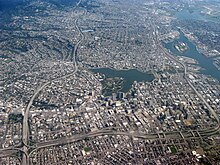

Oakland is in the eastern region of the San Francisco Bay.
The United States Census Bureau says the city's total area is 78.0 square miles (202 km2), including 55.8 square miles (145 km2) of land and 22.2 square miles (57 km2) (28.48 percent) of water.
Oakland's highest point is near Grizzly Peak Blvd, east of Berkeley, just over 1,760 feet (540 m) above sea level at about 37°52′43″N 122°13′27″W / 37.8786°N 122.2241°W. Oakland has 19 miles (31 km) of shoreline,[83] but Radio Beach is the only beach in Oakland.
Oaklanders refer to their city's terrain as "the flatlands" and "the hills". Until recent waves of gentrification, these terms also symbolized Oakland's deep economic divide, with "the hills" being more affluent communities. About two-thirds of Oakland lies in the flat plain of the East Bay, with one-third rising into the foothills and hills of the East Bay range.
Ruptures along the nearby San Andreas Fault caused severe earth movement in the San Francisco Bay Area in 1906 and 1989. San Andreas quakes induces creep (movement occurring on earthquake faults) in the Hayward fault, which runs directly through Oakland, Berkeley, San Jose and other Bay Area cities.[84]

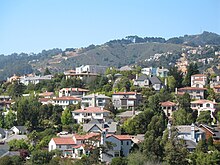
Oakland has more than 50 distinct neighborhoods. The city's greater divisions include downtown Oakland and its greater Central Business District, Lake Merritt, East Oakland, North Oakland, West Oakland, and the Oakland Hills. East Oakland, which includes the East Oakland Hills, encompasses more than half of Oakland's land area, stretching from Lakeshore Avenue on the east shore of Lake Merritt southeast to the San Leandro border. North Oakland encompasses the neighborhoods between downtown and Berkeley and Emeryville. West Oakland is the area between downtown and the Bay, partially surrounded by the Oakland Point, and encompassing the Port of Oakland. In 2011, Oakland was ranked the tenth most walkable city in the United States by Walk Score.[85]
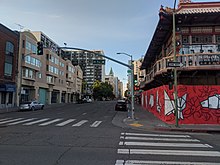
Lake Merritt, an urban estuary near downtown, is a mix of fresh and salt water draining in and out from the Oakland Harbor at the San Francisco Bay and one of Oakland's most notable features.[86] It was designated the United States' first official wildlife refuge in 1870.[87] Originally a marsh-lined wildlife haven, Lake Merritt was dredged and bordered with parks from the 1890s to the 1910s. Despite this reduction in habitat, Oakland is home to a number of rare and endangered species, many of which are localized to serpentine soils and bedrock. Lake Merritt is surrounded by residential and business districts, including downtown and Grand Lake.
The city of Piedmont, incorporated in Oakland's central foothills after the 1906 earthquake, is a small independent city surrounded by the city of Oakland.
Oakland has a warm-summer Mediterranean climate (Köppen Csb) with an average of 260 sunny days per year. In general, the city features warm, dry summers, and cool, wet winters.
Based on data gathered by the National Oceanic and Atmospheric Administration, Oakland is ranked No. 1 in climate among U.S. cities.[88] Oakland's climate is typified by the temperate and seasonal Mediterranean climate. Summers are usually dry and warm and winters are cool and damp. It has features found in both nearby coastal cities such as San Francisco and inland cities such as San Jose, making it warmer than San Francisco and cooler than San Jose. Its position on San Francisco Bay across from the Bay Bridge means the northern part of the city can have cooling maritime fog. It is far enough inland that the fog often burns off by midday, allowing it to have typically sunny California days. The hills tend to have more fog than the flatlands, as the fog drifts down from Berkeley.
The U.S. Weather Bureau kept weather records in downtown Oakland from October 4, 1894, to July 31, 1958. During that time, the record high temperature was 104 °F (40 °C) on June 24, 1957, and the record low temperature was 24 °F (−4 °C) on January 23, 1949. Dry, warm offshore "Diablo" winds (similar to the Santa Ana winds of Southern California) sometimes occur, especially in fall, and raise the fire danger. In 1991, such an episode allowed the catastrophic Oakland Hills fire to spread and consume many homes.
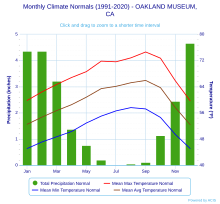
Oakland, like much of Northern California, is susceptible to winter rainstorms and Atmospheric rivers. The wettest "rain year" was from July 1997 to June 1998 with 47.76 inches (1,213.1 mm) and the driest from July 2020 to June 2021 with 8.03 inches (204.0 mm). The most rainfall in one month was 15.35 inches (390 mm) in January 1911. The most rainfall in 24 hours was 4.75 inches (121 mm) on December 31, 2022.[89] Rainfall near the bayfront is only 23 inches (580 mm), but is higher in the Oakland Hills to the east (up to 30 inches [760 mm]), with nearly all precipitation falling between November and April.
Overnight lows are mild. Oakland seldom experiences warm nights with the warmest recorded night of 72 °F (22 °C) in September 1971 and an average of 64 °F (18 °C) for the annual warmest low.[90] The coldest day of the year averages a mild 50 °F (10 °C) and has never been recorded below 36 °F (2 °C).[90]
The National Weather Service today has two official weather stations in Oakland: Oakland International Airport and the Oakland Museum (established 1970).
| Climate data for Oakland, California (1991–2020 normals, extremes 1970–present) | |||||||||||||
|---|---|---|---|---|---|---|---|---|---|---|---|---|---|
| Month | Jan | Feb | Mar | Apr | May | Jun | Jul | Aug | Sep | Oct | Nov | Dec | Year |
| Record high °F (°C) | 78 (26) |
82 (28) |
88 (31) |
97 (36) |
105 (41) |
106 (41) |
103 (39) |
100 (38) |
109 (43) |
103 (39) |
84 (29) |
75 (24) |
109 (43) |
| Mean maximum °F (°C) | 68.6 (20.3) |
72.5 (22.5) |
76.7 (24.8) |
82.2 (27.9) |
84.2 (29.0) |
88.7 (31.5) |
86.0 (30.0) |
87.5 (30.8) |
90.6 (32.6) |
87.7 (30.9) |
77.1 (25.1) |
68.0 (20.0) |
92.6 (33.7) |
| Mean daily maximum °F (°C) | 59.8 (15.4) |
62.4 (16.9) |
64.7 (18.2) |
66.8 (19.3) |
68.6 (20.3) |
71.8 (22.1) |
71.6 (22.0) |
72.8 (22.7) |
74.6 (23.7) |
72.7 (22.6) |
65.8 (18.8) |
59.7 (15.4) |
67.6 (19.8) |
| Daily mean °F (°C) | 52.5 (11.4) |
54.7 (12.6) |
56.7 (13.7) |
58.5 (14.7) |
60.8 (16.0) |
63.4 (17.4) |
64.1 (17.8) |
65.2 (18.4) |
65.9 (18.8) |
63.7 (17.6) |
57.6 (14.2) |
52.4 (11.3) |
59.6 (15.3) |
| Mean daily minimum °F (°C) | 45.1 (7.3) |
47.1 (8.4) |
48.7 (9.3) |
50.3 (10.2) |
52.9 (11.6) |
55.0 (12.8) |
56.6 (13.7) |
57.6 (14.2) |
57.2 (14.0) |
54.6 (12.6) |
49.4 (9.7) |
45.1 (7.3) |
51.6 (10.9) |
| Mean minimum °F (°C) | 37.9 (3.3) |
40.2 (4.6) |
42.4 (5.8) |
45.0 (7.2) |
49.4 (9.7) |
51.9 (11.1) |
54.0 (12.2) |
55.6 (13.1) |
53.6 (12.0) |
49.0 (9.4) |
41.7 (5.4) |
37.5 (3.1) |
36.4 (2.4) |
| Record low °F (°C) | 25 (−4) |
28 (−2) |
32 (0) |
35 (2) |
39 (4) |
43 (6) |
48 (9) |
48 (9) |
41 (5) |
36 (2) |
31 (−1) |
26 (−3) |
25 (−4) |
| Average precipitation inches (mm) | 4.35 (110) |
4.35 (110) |
3.21 (82) |
1.37 (35) |
0.75 (19) |
0.20 (5.1) |
0.00 (0.00) |
0.05 (1.3) |
0.10 (2.5) |
1.13 (29) |
2.44 (62) |
4.66 (118) |
22.61 (573.9) |
| Average precipitation days (≥ 0.01 in) | 10.4 | 10.0 | 10.4 | 5.9 | 3.7 | 1.1 | 0.1 | 0.3 | 0.8 | 3.0 | 6.5 | 10.5 | 62.7 |
| Source: NOAA[91][92] | |||||||||||||
The higher rainfall in the hills supports woods of oak, madrona, pine, fir and a few redwood groves in the wetter areas. Before being logged in the 19th century, some of the tallest redwood trees in California (used for navigation by ships entering the Golden Gate) may have stood in the Oakland Hills. One old stump 30 feet (9.1 m) in diameter can be seen near Redwood Regional Park. Sunny, drier slopes are grassy or covered in scattered oaks and chaparral brush. Australian eucalyptus trees have been extensively planted in many areas, as they come from a similar climate.
| Census | Pop. | Note | %± |
|---|---|---|---|
| 1860 | 1,543 | — | |
| 1870 | 10,500 | 580.5% | |
| 1880 | 34,555 | 229.1% | |
| 1890 | 48,682 | 40.9% | |
| 1900 | 66,960 | 37.5% | |
| 1910 | 150,174 | 124.3% | |
| 1920 | 216,261 | 44.0% | |
| 1930 | 284,063 | 31.4% | |
| 1940 | 302,163 | 6.4% | |
| 1950 | 384,575 | 27.3% | |
| 1960 | 367,548 | −4.4% | |
| 1970 | 361,561 | −1.6% | |
| 1980 | 339,337 | −6.1% | |
| 1990 | 372,242 | 9.7% | |
| 2000 | 399,484 | 7.3% | |
| 2010 | 390,724 | −2.2% | |
| 2020 | 440,646 | 12.8% | |
| 2023 (est.) | 436,504 | −0.9% | |
| U.S. Decennial Census[93] | |||
The 2020 United States Census[94] reported Oakland had a population of 440,646. The population density was 7,898.30 inhabitants per square mile (3,049.55/km2).
This section needs expansion. You can help by adding to it. (July 2023) |
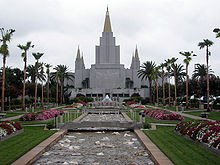

34.95% of people in Oakland are affiliated with a religion, in a total of 417 congregations.[95]
Major places of worship in Oakland include –
The 2020 United States Census[94] reported that the racial makeup of Oakland was 156,429 (35.5%) White, 104,873 (23.8%) Black or African American, 68,300 (15.5%) Asian, 2,643 (0.6%) Pacific Islander, 3,965 (0.9%) Native American, and 30,404 (6.9%) multiracial (two or more races). There were 118,974 (27.0%) of Hispanic or Latino ancestry, of any race.
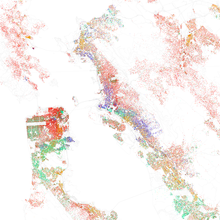
| Historical racial composition | 2022[96] | 2020 | 2010[97] | 1990[98] | 1970[98] | 1940[98] |
|---|---|---|---|---|---|---|
| White | 33.4% | 30.0% | 34.5% | 32.5% | 59.1% | 95.3% |
| —Non-Hispanic | 28.6% | 27.3% | 25.9% | 28.3% | 52.0%[a] | n/a |
| Black or African American | 22.0% | 23.8% | 28.0% | 43.9% | 34.5% | 2.8% |
| Hispanic or Latino (of any race) | 27.2% | 27.0% | 25.3% | 13.9% | 7.6%[a] | n/a |
| Asian | 15.7% | 16.1% | 16.8% | 14.8% | 4.8% | – |
From the 2010 United States Census[97] the racial makeup of Oakland was 134,925 (34.5%) White (non-Hispanic White 25.9%), 129,471 (28.0%) African American, 3,040 (0.8%) Native American, 65,811 (16.8%) Asian (8.7% Chinese, 2.2% Vietnamese, 1.6% Filipino, 0.7% Cambodian, 0.7% Laotian, 0.6% Korean, 0.5% Japanese, 0.5% Indian, 0.1% Mongolian), 2,222 (0.6%) Pacific Islander (0.3% Tongan), 53,378 (13.7%) from other races, and 21,877 (5.6%) from two or more races. There were 99,068 people of Hispanic or Latino ancestry, of any race (25.4%). 18.1% of the population were of Mexican descent, 1.9% Salvadoran, 1.3% Guatemalan, and 0.7% Puerto Rican.
| Race / Ethnicity (NH = Non-Hispanic) | Pop 2000[99] | Pop 2010[100] | Pop 2020[101] | % 2000 | % 2010 | % 2020 |
|---|---|---|---|---|---|---|
| White alone (NH) | 93,953 | 101,308 | 120,187 | 23.52% | 25.93% | 27.28% |
| Black or African American alone (NH) | 140,139 | 106,637 | 91,561 | 35.08% | 27.29% | 20.28% |
| Native American or Alaska Native alone (NH) | 1,471 | 1,214 | 1,371 | 0.37% | 0.31% | 0.31% |
| Asian alone (NH) | 60,393 | 65,127 | 69,906 | 15.12% | 16.67% | 15.86% |
| Pacific Islander alone (NH) | 1,866 | 2,081 | 2,668 | 0.47% | 0.53% | 0.61% |
| Other race alone (NH) | 1,229 | 1,213 | 2,964 | 0.31% | 0.31% | 0.67% |
| Mixed race or Multiracial (NH) | 12,966 | 14,076 | 25,146 | 3.25% | 3.60% | 5.71% |
| Hispanic or Latino (any race) | 87,467 | 99,068 | 126,843 | 21.89% | 25.35% | 28.79% |
| Total | 399,484 | 390,724 | 440,646 | 100.00% | 100.00% | 100.00% |
|
Racial Makeup of Oakland (2022)[102] White alone (31.10%) Black alone (20.56%) Native American alone (1.25%) Asian alone (15.94%) Pacific Islander alone (0.29%) Other race alone (19.59%) Two or more races (11.27%)
|
Racial/Ethnic Makeup of Oakland excluding Hispanics from Racial Categories (2022)[102] White NH (29.65%) Black NH (20.13%) Native American NH (0.23%) Asian NH (15.76%) Pacific Islander NH (0.29%) Other race NH (1.00%) Two or more races NH (6.10%) Hispanic Any Race (26.83%)
|
Racial Makeup of Hispanics in Oakland (2022)[102] White alone (5.42%) Black alone (1.60%) Native American alone (3.78%) Asian alone (0.66%) Pacific Islander alone (0.00%) Other race alone (69.30%) Two or more races (19.23%)
|
According to 2022 US Census Bureau estimates, Oakland's population declined to 430,531, and was 31.1% White (29.7% Non-Hispanic White and 1.5% Hispanic White), 20.6% Black or African American, 1.3% Native American and Alaskan Native, 15.9% Asian, 0.3% Pacific Islander, 19.6% Other Race, and 11.3% from two or more races.[102]
White Americans are the largest racial/ethnic group at either 31.1% (including White Hispanics) or 29.7% (excluding White Hispanics).[102]
Hispanics have been the second largest ethnic group since 2012 when they displaced the Black population. However, Black Americans still form the second largest racial group. By ethnicity, 26.8% of the total population is Hispanic-Latino (of any race) and 73.2% is Non-Hispanic (of any race).[102] The majority of Hispanics self-identify as Some Other Race (69.3%) with the remainder choosing White (5.4%), Multiracial (19.2%), Black (1.6%), American Indian and Alaskan Native (3.8%), Asian (0.7%), and Hawaiian and Pacific Islander (0.1%).[102]
The Black population is the third largest ethnic group and second largest racial group at either 20.6% (including Black Hispanics) or 20.1% excluding Black Hispanics.[102]
The Asian population continues to remain the fourth largest group at 15.9% of the population.[102]
5.1% are of English ancestry, French (except Basque), 1.4% German, 6.1% Irish - 6.2% Italian, 3.1% Norwegian, 1.1% Polish - 1.7% Scottish and 1.0%Subsaharan African 2.5%.[103]
The most common ancestries in Oakland are German, Irish, English, Italian and European. Spanish and Chinese are the most common non-English spoken languages.[104]
The greater Oakland area[specify] has the fifth largest cluster of "elite zip codes" ranked by the number of households with the highest combination of income and education.[105] 37.9% of residents over 25 years of age have bachelor's degree or higher.[106] Oakland ranked among the top cities with residents with bachelor's degrees and graduate degrees per square mile.[107]
Oakland ranks in the top 20 of American cities in median household income, with a 2012 value of US$51,863.[108] In 2012, the median income for a household in the city was US$51,863 and the median income for a family was US$59,459. The mean income for a household was US$77,888 and the mean income for a family was US$90,948. Males had a median income of US$50,140 versus US$50,304 for females.[109] The unemployment rate as of December 2013 was 9.7%.[110]
In 2007 approximately 15.3 percent of families and 17.0 percent of the general population were below the poverty line, including 27.9 percent of those under age 18 and 13.1 percent of those age 65 or over. 0.7% of the population is homeless.[111] Home ownership is 41%[111] and 14% of rental units are subsidized.[111]
As of the census[112] of 2000, 19.4% of the population and 16.2% of families were below the poverty line. Out of the total population, 27.9% of those under the age of 18 and 13.1% of those 65 and older were living below the poverty line.
The census reported 382,586 people (97.9% of the population) lived in households, 5,675 (1.5%) lived in non-institutionalized group quarters, and 2,463 (0.6%) were institutionalized.
There were 153,791 households, out of which 44,762 (29.1%) had children under the age of 18 living in them, 50,797 (33.0%) were opposite-sex married couples living together, 24,122 (15.7%) had a female householder with no husband present, 8,799 (5.7%) had a male householder with no wife present. There were 11,289 (7.3%) unmarried opposite-sex partnerships, and 3,442 (2.2%) same-sex married couples or partnerships. 52,103 households (33.9%) were made up of individuals, and 13,778 (9.0%) had someone living alone who was 65 years of age or older. The average household size was 2.49. There were 83,718 families (54.4% of all households); the average family size was 3.27.
The population was spread out, with 83,120 people (21.3%) under the age of 18, 36,272 people (9.3%) aged 18 to 24, 129,139 people (33.1%) aged 25 to 44, 98,634 people (25.2%) aged 45 to 64, and 43,559 people (11.1%) who were 65 years of age or older. The median age was 36.2 years. For every 100 females, there were 94.2 males. For every 100 females age 18 and over, there were 91.8 males.
There were 169,710 housing units at an average density of 2,175.7 per square mile (840.0/km2), of which 153,791 were occupied, of which 63,142 (41.1%) were owner-occupied, and 90,649 (58.9%) were occupied by renters. The homeowner vacancy rate was 3.0%; the rental vacancy rate was 8.5%. 166,662 people (42.7% of the population) lived in owner-occupied housing units and 215,924 people (55.3%) lived in rental housing units.
Oakland has consistently ranked as one of the most ethnically diverse major cities in the country.[113][114] A 2019 analysis by WalletHub showed that Oakland was the most ethnoracially diverse city in the United States.[115] The city's formerly most populous ethnic group, whites, declined from 95.3% in 1940 to 32.5% by 1990, due to a combination of factors, including suburbanization. Oakland became a destination for African Americans in the Great Migration during and after World War II as they gained high-paying jobs in the defense industry. Blacks have formed a plurality in Oakland for many years, peaking in 1980 at about 47% of the population.
Oakland's Black population decreased by nearly 25 percent between 2000 and 2010.[116] The city's demographics have changed due to a combination of rising housing prices associated with gentrification and with blacks relocating to better (and in many cases more affordable) housing in Bay Area suburbs or moving to the Southern United States in a reverse migration, where conditions (including race relations) are considered to have improved in comparison to previous generations.[117][118][119] These trends and cultural shifts have led to a decline among some of Oakland's long standing black institutions, such as churches, businesses and nightclubs, which had developed during the growing years of the 1950s through 1970.[120]
In the 2010 census African Americans maintained their status as Oakland's single largest ethnic group, with 27% of the population, followed by non-Hispanic whites at 25.9%, and Hispanics of any race at 25.4%.[121] Ethnic Asians constitute 17%, followed by smaller minority groups.
Many immigrants have settled in the city. Immigrants and others have marched by the thousands down Oakland's International Boulevard in support of legal reforms benefiting undocumented immigrants.[122]
An analysis by the Urban Institute of U.S. Census 2000 numbers showed Oakland had the third-highest concentration of gays and lesbians among the 50 largest U.S. cities, behind San Francisco and Seattle. Census data showed that among incorporated places that have at least 500 female couples, Oakland had the nation's largest proportion. In the 2000 census, 2,650 lesbian couples identified as such in Oakland; one in every 41 Oakland couples identified as a same-sex female partnership.[123][124]
As of 2020, the San Francisco-Oakland Metro shows indications of having the greatest intensity of gentrification nationally, with over 31% of eligible neighborhoods gentrifying. Gentrifying neighborhoods showed significant increases in median home value, median household income, percentage of college educated residents, but also in economic inequality.[125]
Historically low-income neighborhoods have been rapidly changed by new, higher-income residents as high-wage tech workers and expensive housing have continued to push lower-wage residents out of Oakland.[125] In West Oakland, for example, median household income rose from $80,700 to $86,300 between 2010 and 2017, while the percent of population with four-year degrees rose from one-third to nearly one-half, according to the National Community Reinvestment Coalition.[126]
Big tech companies have continued to transform the communities and culture of Oakland as modern apartments have appeared, housing prices have spiked, and many prior working-class residents have moved to suburbs further inland.[127]
According to 2015 data compiled by the Bay Area Equity Atlas, 91% of low-income households of color were either in neighborhoods that were gentrifying or were at risk of gentrification at the time.[128] The number was higher for individual low-income communities, with 96% of Native American households in neighborhoods that either experienced gentrification or were at risk of being gentrified, followed by Latino households at 94%, Black households at 92%, and Asian or Pacific Islander households at 88%.[128]
| 1992 | 175[131] |
| 1995 | 153[132] |
| 1996 | 102[132] |
| 1997 | 99[133] |
| 1998 | 72[133] |
| 1999 | 60[133] |
| 2000 | 85[134] |
| 2001 | 87[134] |
| 2002 | 113[134] |
| 2003 | 114[134] |
| 2004 | 88[134] |
| 2005 | 94[134] |
| 2006 | 148[134] |
| 2007 | 127[134] |
| 2008 | 125[134] |
| 2009 | 110[134] |
| 2010 | 95[134] |
| 2011 | 110[134] |
| 2012 | 131[134] |
| 2013 | 92[134] |
| 2014 | 86[135] |
| 2015 | 83[136] |
| 2016 | 85[136] |
| 2017 | 72[137] |
| 2018 | 75[130] |
| 2019 | 78[129] |
| 2020 | 109[129] |
| 2021 | 134[138] |
| 2022 | 120[138] |
A 2014 study by the Chief Justice Earl Warren Institute on Law & Social Policy at the University of California, Berkeley School of Law examined crime in the city from 1987 to 2012 and concluded that "The story of crime in Oakland over the last 25 years is a nuanced one, as there are both positive and negative aspects of the crime trends."[133] Crime dramatically decreased since the early 1990s but the city has continued to suffer from serious violent crime problems.[133] Crime trends generally tracked comparison cities of Fresno, Richmond, Sacramento, and Stockton "in terms of direction if not magnitude"; this suggested that crime trends are regional rather than city-specific.[133]
A 2007 journal article identified crime in Oakland as being fueled by the dramatic increase of street narcotics sales and use since the 1970s, with Oakland becoming a major west-coast hub for heroin and cocaine distribution. Subsequent battle for control over the lucrative narcotics trade incited gang conflicts and violence, with shootings becoming a regular occurrence. A concurrent rise in rape, robbery, burglary, auto-theft and other crimes occurred as well. Prior to 1960, there had been successful government-funded social programs whereby rebellious teens were enrolled in youth centers that would teach them proper values and improve their behavior. Similar programs since then have been inconsistent.[139]
By the 1970s, the police and Federal Bureau of Investigation (FBI) used military tactics such as SWAT teams, infiltration and counter intelligence in an attempt to counter groups such as the Black Panthers (responsible for several police ambushes), the S.L.A. and organized drug gangs such as the "69 Mob", with increases in arrests, prosecutions, and imprisonment.[139] During the first decade of the 21st century, Oakland has consistently been listed as one of the most dangerous large cities in the United States.[140]
The number of Oakland Police Department officers has varied from a low of 626 (in 1996 and in 2012) to a high of 814 (in 2002).[133] There were 723 officers at the end of 2015.[131] The city's strategic plan recommended 925 officers, and an independent study commissioned by the city in the mid-1990s recommended 1,200 officers.[141][142][143]
Among Oakland's 35 police patrol beats, violent crime remains a serious problem in specific East and West Oakland neighborhoods. In 2008, homicides were concentrated: 72% occurred in three City Council districts, District 3 in West Oakland and Districts 6 and 7 in East Oakland, although these districts have 44% of Oakland's residents.[144]
In 2012, Oakland implemented Operation Ceasefire, a gang violence reduction plan used in other cities, based in part on the research and strategies of author David M. Kennedy.[145][146][147][148]
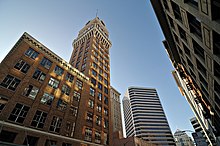
Oakland is a major West Coast port, and the fifth-busiest in the United States by cargo volume.[149] The Port of Oakland handles 99% of all containerized goods moving through Northern California, representing $41 billion worth of international trade.[150][151] There are nearly 200,000 jobs related to marine cargo transport in the Oakland area.[152] These jobs range from minimum wage hourly positions to Transportation Storage and Distribution Managers who earn an annual average salary of US$91,520.[153]
The Port of Oakland was an early innovator/pioneer in the technologies of Intermodal Containerized Shipping. The city is also home to several major corporations including Kaiser Permanente, Clorox, and Dreyer's ice cream.[154] Tech companies such as Ask.com and Pandora Radio are in Oakland,[155] and in recent years many start-up high tech and green energy companies have found a home in the downtown neighborhoods of Uptown, City Center, Jack London Square and Lake Merritt Financial District.[156]
As of 2013[update], the San Francisco-Oakland-Hayward metropolitan area has a gross domestic product (GDP) of US$360.4 billion, ranking eighth among metropolitan areas in the United States.[157] In 2014, Oakland was amongst the best cities to start a career, the highest ranked city in California after San Francisco. Additionally, Oakland ranked fourth in cities with professional opportunities.[158] Numerous companies in San Francisco continue to expand in or migrate over to Oakland.[159]
Oakland experienced an increase of both its population and of land values in the early-to-mid first decade of the 21st century. The 10k Plan, which began during former mayor Elihu Harris' administration, and intensified during former mayor Jerry Brown's administration resulted in several thousand units of new multi-family housing and development. In 2023, Oakland became the first American city ever to lose three professional major league sports teams to other cities within a five-year span.[82]
As of 2020[update], the top employers in the city were:[160]
| # | Employer | # of Employees |
|---|---|---|
| 1 | Kaiser Permanente | 12,500+ |
| 2 | County of Alameda | 8,000+ |
| 3 | Alameda Health System | 5,300+ |
| 4 | Oakland Unified School District | 5,000+ |
| 5 | City of Oakland | 4500+ |
| 6 | Bay Area Rapid Transit | 4,000+ |
| 7 | State of California | 3,500+ |
| 8 | Children's Hospital Oakland | 2,500+ |
| 9 | Southwest Airlines | 2,500+ |
| 10 | Sutter Bay Hospitals and Foundation | 2,000+ |
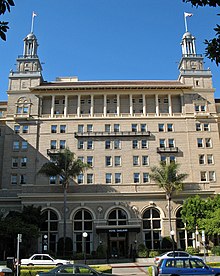
In 2013, over 2.5 million people visited Oakland, contributed US$1.3 billion into the economy.[161] Oakland has been experiencing an increase in hotel demand. Occupancy is 74%, while RevPAR (Revenue Per Available Room) increased by 14%, the highest increase of any big city in the western region of the United States.[162] Both Oakland and San Francisco were forecasted to experience the highest increases in ADR (Average daily rate).[163]
In recent years, Oakland has gained national recognition as a travel destination. In 2012, The New York Times named Oakland the top North American city to visit, highlighting its growing number of sophisticated restaurants and bars, top music venues, and increasing nightlife appeal.[164] Oakland also took the No. 16 spot in "America's Coolest Cities", ranked by metrics like entertainment options and recreational opportunities per capita, etc.[165] In 2013, Oakland topped the No. 1 spot in "America's Most Exciting Cities", notably having the most movie theaters, theater companies, and museums per square mile.[166] In "America's Most Hipster Cities", Oakland took the number-5 spot, cited for luring San Francisco "hippies" into the city.[167] Oakland has also increased its travel destination allure internationally.[168]
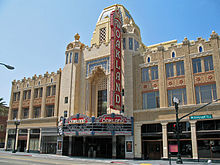
Oakland has a vibrant art scene and claims the highest concentration of artists per capita in the United States.[169] In 2013, Oakland was designated as one of America's top twelve art communities, recognizing Downtown (including Uptown), Chinatown, Old Oakland, and Jack London Square as communities "that have most successfully combined art, artists and venues for creativity and expression with independent businesses, retail shops and restaurants, and a walkable lifestyle to make vibrant neighborhoods."[170]
Galleries exist in various parts of Oakland, with the newest additions centered mostly in the Uptown area. Oakland ranked 11th in cities for designers and artists.[171] The city is a renowned culinary hotbed, offering both a wide variety and innovative approaches to diverse cuisines in restaurants and markets, often featuring locally grown produce and international styles such as French, Italian, Portuguese/Spanish, Ethiopian, Asian, Latin American, as well as Caribbean, Southern United States/Louisiana Creole, etc., all of which reflects the culinary traditions of the city's ethnically diverse population.
Historically a focal point of the West Coast blues and jazz scenes, Oakland is also home to musicians representing such genres as rhythm and blues, gospel, funk, punk, heavy metal, Rap/Gangsta rap, and hip hop. Artists who come out of Oakland include Green Day, Tower of Power, Mistah F.A.B., E-40, Too Short, Tupac Shakur, Raphael Saadiq, MC Hammer, Keyshia Cole, Kehlani, G-Eazy, Del the Funky Homosapien, Edwin Hawkins, Tony! Toni! Toné! and many more.

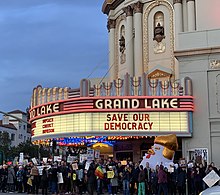
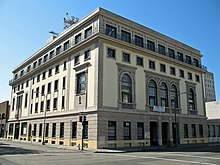

Downtown Oakland has an assortment of bars and nightclubs. They include dive bars, dance clubs, modern lounges and jazz bars. The Paramount Theater features headlining musical tours and productions, while Fox Oakland Theatre draws various musical genres including jam bands, rock, punk, blues, jazz, and reggae. The Paramount and Fox theaters often book simultaneous events, creating busy nights uptown.[172] In 2012, Oakland was dubbed a "New Sin City", following its 2010 decision to relax its cabaret laws, which gave a boost to its nightclub and bar scene.[173]
Recent years have seen the growth of the Oakland Art Murmur event, occurring in the Uptown neighborhood the first Friday evening of every month.[174] The event attracts around 20,000 people along twenty city blocks, featuring live performances, food trucks, and over 30 galleries and venues.[175][176]
Gertrude Stein wrote about Oakland in her 1937 book Everybody's Autobiography "There is no there there", upon learning that the neighborhood where she lived as a child had been torn down to make way for an industrial park. The quote is usually misconstrued to refer to Oakland as a whole.[177][178]
Modern-day Oakland has made steps to rebuke Stein's claim with a statue downtown titled There. In 2005 a sculpture called HERETHERE was installed by the City of Berkeley on the Berkeley-Oakland border at Martin Luther King Jr. Way. The sculpture consists of eight-foot-tall letters spelling "HERE" and "THERE" in front of the BART tracks as they descend from their elevated section in Oakland to the subway through Berkeley.[179]
Oakland's former baseball team, the Oakland Athletics of Major League Baseball won three consecutive World Series championships in 1972, 1973, and 1974, and appeared in another three consecutive World Series from 1988 to 1990, winning their fourth championship in 1989. Formerly based at the Oakland Coliseum, the Oakland Athletics announced plans to move to Las Vegas to play at a new 33,000-seat partially retractable ballpark on the Las Vegas Strip with the team itself spending three seasons at Sutter Health Park in West Sacramento as a temporary home. The move leaves Oakland without a major professional sports team for the first time since 1959.[82]
Oakland's former football team, the Oakland Raiders of the National Football League (NFL), won Super Bowl XI in 1976 and Super Bowl XV in 1980, during their tenure in Oakland. The Raiders relocated to Las Vegas in 2020 and are now known as the Las Vegas Raiders.
Oakland's former basketball team, the Golden State Warriors won the 1974–75, 2014–15, 2016–17, and the 2017–18 NBA championships, while losing in 2016 and 2019. The Warriors, whose primary owners reside in Southern California, announced in April 2014 that they would leave Oakland once their new arena was built across the Bay in San Francisco. In 2019, the Warriors built and moved to Chase Center across the Bay. Since the team remained in the Bay Area, they decided not to revert to the San Francisco Warriors name it had in its first stint with the city.
The Oakland Roots SC are a professional soccer team that was formed in 2018. The Roots began play in 2019 in a new third division professional league known as the National Independent Soccer Association, however, the team announced that it would move into the second division of US professional soccer, and play in the USL Championship beginning in the 2021 season. The Roots play their home matches at Laney College Football Stadium.
The Oakland Soul SC, a woman's professional soccer club will begin play in May 2023 as an expansion team in the USL W League; they will also play their home matches at LCFS.
Oakland's former hockey team, the California Golden Seals were a professional ice hockey club that competed in the National Hockey League (NHL) from 1967 to 1976. Based in Oakland, they played their home games at the Oakland–Alameda County Coliseum Arena. The Seals were one of six teams added to the league as part of the 1967 NHL expansion. Initially named the California Seals, the team was renamed the Oakland Seals during the 1967–68 season and then the Bay Area Seals in 1970 before becoming the California Golden Seals the same year. The Seals were the least successful of the teams added in the 1967 expansion, never earning a winning record and only making the playoffs twice in nine seasons of play. Off the ice, they were plagued by low attendance. The franchise was relocated prior to the beginning of the 1976–77 season to become the Cleveland Barons, who would cease operation two years later.
Oakland's ultimate team, Oakland Spiders, relocated to Oakland in 2022 after playing eight years as the San Jose Spiders.
| Club | Sport | Founded | League | Venue |
|---|---|---|---|---|
| Oakland Roots SC | Soccer | 2019 | USLC | Pioneer Stadium |
| Oakland Spiders | Ultimate | 2014 (in Oakland since 2022) | AUDL | Oakland Technical High School |
| Oakland Ballers | Baseball | 2023 | MiLB (PL) | Laney College |

Oakland's former sports teams include:


Oakland has many parks and recreation centers which total 5,937 acres (2,403 ha). In its 2013 ParkScore ranking, The Trust for Public Land, a national land conservation organization, reported that Oakland had the 18th best park system among the 50 most populous U.S. cities.[180] In 2013, Oakland ranked fourth among American cities as an urban destination for nature lovers.[181]
Some of the city's most notable parks include:
Additionally, the following seven East Bay Regional Parks are entirely or partially in the city of Oakland:


Oakland has a mayor-council government. The mayor is elected at-large for a four-year term. The Oakland City Council has eight council members representing seven districts in Oakland with one member elected at-large and others from single-member districts; council members serve staggered four-year terms. The mayor appoints a city administrator, subject to the confirmation by the City Council, who is the city's chief administrative officer. Other city officers include: city attorney (elected), city auditor (elected), and city clerk (appointed by city administrator).[183] Oakland's mayor is limited to two terms. There are no term limits for the city council.
Oakland City Hall was evacuated after the 1989 Loma Prieta earthquake until US$80M seismic retrofit and hazard abatement work was complete in 1995.[184] City offices had to be housed in leased space and other locations.
Jean Quan was elected mayor in November 2010, beating Don Perata and Rebecca Kaplan in the city's first ranked choice balloting.[185] This new system is intended to increase voters' ability to choose preferred candidates, as they can combine ranked votes when several candidates are competing. Sheng Thao, the first Hmong American mayor of a major city in the United States, took office in 2023.
Oakland is also part of Alameda County, for which the Government of Alameda County is defined and authorized under the California Constitution, California law, and the Charter of the County of Alameda.[186] The County government provides countywide services such as elections and voter registration, law enforcement, jails, vital records, property records, tax collection, public health, and social services. The County government is primarily composed of the elected five-member Board of Supervisors, other elected offices including the Sheriff/Coroner, the District Attorney, Assessor, Auditor-Controller/County Clerk/Recorder, and Treasurer/Tax Collector, and numerous county departments and entities under the supervision of the County Administrator.
In the California State Legislature, Oakland is in the 9th Senate District, represented by Democrat Tim Grayson,[8] and is split between the 14th, 15th, and 18th Assembly districts, represented by Buffy Wicks, Anamarie Avila Farias, and Mia Bonta, respectively.[9] In the United States House of Representatives, Oakland is in California's 12th congressional district, represented by Democrat Barbara Lee.[10]
Oakland was a Republican Party bastion from the 1860s to the 1950s, with positions expressed by the Republican-oriented Oakland Tribune newspaper. In the 1960s, the majority of voters began to favor liberal policies and the Democratic Party.[187][188] Oakland has the second highest percentage of registered Democrats of any of the incorporated cities in Alameda County, with Berkeley coming in first.
The last Republican presidential candidate to receive at least one-third of vote in Oakland was Richard Nixon in 1972. Since then, the Republican percentage of the vote has generally declined in each successive election.
According to the California Secretary of State, as of February 10, 2019, Oakland has 245,111 registered voters. Of those, 159,771 (65.2%) are registered Democrats, 9,544 (3.9%) are registered Republicans, and 65,416 (26.7%) have declined to state a political party.[189] Oakland is widely regarded as being one of the most liberal major cities in the nation. The Cook Partisan Voting Index of Congressional District 12, which includes Oakland and Berkeley, is D+40, making it the most Democratic congressional district in California and the fourth most Democratic district in the US.[190]
On November 27, 2023, the City Council unanimously passed a resolution calling for a ceasefire in Israel's war on Hamas,[191] after hearing more than 500 residents speak on the topic.[192]
The Oakland Unified School District (OUSD), which covers the city except for Sheffield Village, operates most of Oakland's public schools. Due to financial troubles and administrative failures, it was in receivership by the state of California from 2002 to 2008.[193] As of 2015[update], the Oakland Unified School District includes 86 division-run schools and 32 charter schools; the district also manages several adult education programs. As of 2015[update] there are 48,181 K–12 students; among division-run schools, there are 4,600 plus employees.[194]
OUSD test scores historically lag behind the rest of California, in particular due to a high proportion of English-language learners.[195] Some individual schools have much better performance than the citywide average. As of 2013[update], for example, over half the students at Hillcrest Elementary School in the Montclair upper hills neighborhood performed at the "advanced" level in the English portion of the test, and students at Lincoln Elementary School in the Chinatown neighborhood performed at the "advanced" level in the math portion.[196]
Oakland's three largest public high schools are Oakland High School, Oakland Technical High School, and Skyline High School. Other Oakland public high schools include Castlemont High School, Fremont High School, and McClymonds High School, briefly known as Castlemont Community of Small Schools, Fremont Federation of High Schools, and McClymonds Educational Complex, respectively.
Among charter schools in the district, North Oakland Community Charter School (NOCCS), an elementary and middle school, is one of the few public progressive schools in the country.[clarification needed] Other charter schools include the Oakland Military Institute, Oakland School for the Arts, Bay Area Technology School, East Bay Innovation Academy, and Oakland Charter Academy.[197]
There are several religious and secular private high schools, including The College Preparatory School, Head-Royce School, Bishop O'Dowd High School, Holy Names High School, St. Elizabeth High School and Oakland Hebrew Day School. Catholic schools in Oakland are operated by the Roman Catholic Diocese of Oakland also include eight K–8 schools (plus one in Piedmont on the Oakland city border). Northern Light School is a private nonprofit elementary and middle school. Bentley School is an Independent Co-educational K–12, college preparatory school on two campuses in Oakland and Lafayette, California.
In 2017, the Oakland Unified School District has received funding from Pandora in partnership with Little Kids Rock, towards expanding music education programs within the schools. The result from these donations has given teachers from 20 additional Oakland- area schools the ability to participate in an eight-hour professional development workshop, and receive music education instruction from Little Kids Rock. The donation includes providing new instruments, that will benefit over 2,000 Oakland students.[198]
Accredited colleges and universities include:
In 2001, the SFSU Oakland Multimedia Center was opened, allowing San Francisco State University to conduct classes near downtown Oakland.[199] The Oakland Higher Education Consortium and the City of Oakland's Community and Economic Development Agency (CEDA) opened the Oakland Higher Education Center downtown in 2002 to provide "access to multiple higher education service providers within a shared urban facility." Member schools include primary user California State University, East Bay as well as Lincoln University, New College of California, Saint Mary's College of California, SFSU Multimedia Studies Program, UC Berkeley Extension, University of Phoenix and Peralta Community College District.[200][201]
Oakland is served by major television stations broadcasting primarily out of San Francisco and San Jose. The region's Fox O&O, KTVU 2, is based in (and licensed to) Oakland at Jack London Square along with co-owned MyNetworkTV outlet KICU-TV 36 (licensed to San Jose). In addition, the city is served by various AM and FM radio stations as well; AM stations KKSF 910, KMKY 1310 and KNEW 960 are licensed to Oakland.
Oakland was served by the Oakland Tribune, which published its first newspaper on February 21, 1874. The Tribune Tower, which features a large clock, is an Oakland landmark. At key times throughout the day (8:00 am, noon and 5:00 pm), the clock tower carillon plays a variety of classic melodies, which change daily. In 2007, the Oakland Tribune moved its offices from the tower to an East Oakland location, before folding in 2011.[202]
The East Bay Express, a locally owned free weekly paper, is based in Jack London Square and distributed throughout the East Bay.
Oaklandwiki is a thriving (mostly) English-language LocalWiki.
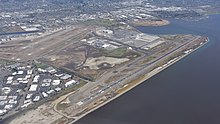
Oakland residents have access to the three major airports of the San Francisco Bay Area: Oakland International Airport, San Francisco International Airport, and San Jose International Airport. Oakland International Airport, within Oakland's city limits, is 4 mi (6.4 km) south of downtown Oakland and serves domestic and international destinations. AC Transit provides 24-hour service to the airport, and BART's Oakland Airport Connector automated guideway transit line provides frequent service between the airport and Oakland Coliseum station.
The city has regional and long-distance passenger train service provided by Amtrak, with stations near Jack London Square and the RingCentral Coliseum. Amtrak's California Zephyr has its western terminus at the nearby Emeryville station.
Historically, the city was served by several train companies, which terminated in different terminals. Santa Fe trains terminated at its Oakland depot, actually located within the city limits of Emeryville at 40th and San Pablo. Southern Pacific trains ended at the 16th Street Station.[203] Western Pacific trains ended at the 3rd and Washington station. However, a common feature was that the different railroads continued one more stop to a station at Oakland Pier.[204] From this latter point passengers would ride ferries to San Francisco.


Data compiled in 2007 by the United States Census Bureau before gasoline price spikes in 2008, showed that 24.3% of Oaklanders used public transportation, walked or used "other means" to commute to work, not including remote work,[205] with 17% of Oakland households being "car free" and/or statistically categorized as having "no vehicles available."[206]
Bus transit service in Oakland and the inner East Bay is provided by the Alameda and Contra Costa Transit District, AC Transit. The district originated in 1958 after the conspiratorial dissolution of the Key System of streetcars. Many AC Transit lines follow old routes of the Key System.[56]

Intercity bus companies that serve Oakland include Greyhound, BoltBus, USAsia, and Hoang Transportation. Megabus no longer serves Oakland.[207]
The metropolitan area is served by Bay Area Rapid Transit (BART) from eight stations in Oakland, served by all BART lines.The system has headquarters in Oakland, with major transfer hubs at MacArthur and 19th Street stations. BART's headquarters was in a building above the Lake Merritt BART station until 2006, when it relocated to the Kaiser Center due to seismic safety concerns.
The Alameda / Oakland Ferry operates ferry service from Jack London Square to Alameda, Oracle Park, Pier 41, the San Francisco Ferry Building, and the South San Francisco Ferry Terminal. Oakland licenses taxi cabs, and has zoned cab stands in its downtown, including a bicycle pedi-cab service.
The Oakland City Council adopted a Bicycle Master Plan in 1999 as a part of the Land Use and Transportation (LUTE) element of Oakland's 1998 General Plan. The creation of the plan was to promote alternatives to the private automobile.[208] The Oakland City Council reaffirmed the bike plan in 2005, revised it in 2007, and reaffirmed it in 2012.[209][208] From 1999 to 2007, the city installed 900 bike racks throughout Oakland, accommodating over 2,000 bicycles.[210] By the end of 2017, over 160 bikeway miles and 9,900 bike parking spaces were constructed.[211] Facilities for parking thousands of bicycles have been installed downtown and in other commercial districts throughout Oakland.[212] According to the U.S. Census Bureau's 2011 American Community Survey, Oakland came in seventh place out of the 100 largest cities in the nation by percentage of people that chose to commute by bike in 2011.[213]
In July 2019, the City of Oakland Department of Transportation announced that it had issued official permits for the deployment of shared e-scooters to four companies: Bird, Clevr, Lime, and Lyft.[214] Oakland requires these operators to educate users on the correct and safe use of scooters, to distribute the scooters equitably throughout the city, to ensure accessibility, and to provide insurance and indemnification.[215]
Oakland is served by several major highways: Eastbound Bay Bridge traffic entering Oakland then splits into three freeways at the MacArthur Maze freeway interchange: Interstate 580 (MacArthur Freeway) heads southeast toward Hayward and eventually to the California Central Valley; Interstate 880 (Nimitz Freeway) runs south to San Jose; and the Eastshore Freeway (Interstate 80/I-580) runs north, providing connections to Sacramento and San Rafael, respectively. Interstate 980 (Williams Freeway) begins its eastbound journey at I-880 in Downtown Oakland before turning into State Route 24 (Grove Shafter Freeway) at I-580. State Route 13 begins as the Warren Freeway at I-580, and runs through a scenic valley in the Montclair District before entering Berkeley. A stub of a planned freeway was constructed at the High Street exit from the Nimitz Freeway, but that freeway extension plan was abandoned.

At the time of the 1989 Loma Prieta earthquake, the Cypress Street Viaduct double-deck segment of the Nimitz Freeway collapsed, killing 42 people. The old freeway segment had passed through the middle of West Oakland, forming a barrier between West Oakland neighborhoods. Following the earthquake, this section was rerouted around the perimeter of West Oakland and rebuilt in 1997–2001. The east span of the San Francisco–Oakland Bay Bridge also suffered damage from the quake when a 50-foot (15-m) section of the upper deck collapsed onto the lower deck; the damaged section was repaired within a month of the earthquake. As a result of Loma Prieta, a significant seismic retrofit was performed on the western span of the Bay Bridge. The eastern span has now been replaced with a dramatic single-tower self-anchoring suspension span.
Two underwater tunnels, the Webster and Posey Tubes, connect the main island of Alameda to downtown Oakland, coming above ground in Chinatown. In addition, the Park Street, Fruitvale, and High Street bridges connect Alameda to East Oakland over the Oakland Estuary.
In the hills, the Leimert Bridge crosses Dimond Canyon, connecting the Oakmore neighborhood to Park Boulevard. The Caldecott Tunnel carries Highway 24 through the Berkeley Hills, connecting central Contra Costa County to Oakland. The Caldecott has four bores.

On April 11, 2020, the City of Oakland launched its Slow Streets Program.[216] This was facilitated in part by the sudden decrease of vehicle traffic that resulted from the state-wide stay-at-home order and school closures in response to the spread of the COVID-19 in California.[217] The goal of the program was to "support safe physical activity and alleviate overcrowding in parks and on trails by discouraging through traffic."[218] This was accomplished by closing 74 miles of streets to through traffic.[219]
Over the course of three months the city installed "soft closure" barriers consisting of signage, traffic cones, and barricades in over 21 miles of city streets.[216] While the primary goal at the time was to encourage socially distanced outdoor physical activities like biking, walking, and jogging, the long term implementation of the Slow Streets Program contributed to the city's traffic calming measures and promoted alternatives to car use as well.[218]
Although the Slow Streets Program was initially praised for its rapid implementation and prioritization of pedestrian safety, the Oakland Department of Transportation quickly came under fire for its failure to collect feedback that represented the opinions of the diverse range of residents whom the program affected.[219] The high engagement with online surveys by wealthy white residents initially suggested an almost universally positive reaction to the program.[220] The disproportionately low number of responses from residents of East Oakland—a largely Black and Latino and low-income area—revealed both the oversight of city officials as well as the shortcomings of urban planning systems' ability to equally benefit different social groups, which consequently perpetuates inequalities like the transport divide.
After the flaws of the feedback forms were brought to light, city planners made concentrated efforts to meet with representatives from different community groups who in turn stressed that simply closing streets to through traffic was not enough to protect pedestrians from dangerous driving.[220] In response the city expressed its commitment to its local residents calling for road traffic safety by rolling out Slow Streets: Essential Places, a phase of the program which installed cones and signage at dangerous traffic areas in order to make grocery stores, COVID-19 test sites, and food distribution sites easily and safely accessible.[217]
Freight service, which consists primarily of moving shipping containers to and from the Port of Oakland, is provided today by Union Pacific Railroad (UP), and to a lesser extent by BNSF Railway (which now shares the tracks of the UP between Richmond and Oakland).
Historically, Oakland was served by several railroads. Besides the transcontinental line of the Southern Pacific, there was also the Santa Fe (whose Oakland terminal was actually in Emeryville), the Western Pacific Railroad (who built a pier adjacent to the SP's), and the Sacramento Northern Railroad (eventually absorbed by the Western Pacific, which in turn was absorbed by UP in 1983).
As one of the three major ports on the West Coast of the United States, the Port of Oakland is the largest seaport on San Francisco Bay and the fifth busiest container port in the United States. It was one of the earliest seaports to switch to containerization and to intermodal container transfer,[221] thereby displacing the Port of San Francisco, which never modernized its waterfront. One of the earlier limitations to growth was the inability to transfer containers to rail lines, all cranes historically operating between ocean vessels and trucks. In the 1980s, the Port of Oakland began the evaluation of development of an intermodal container transfer capability, i.e., facilities that now allow trans-loading of containers from vessels to either trucks or rail modes.[222]
Public water supply and sewage treatment are provided by East Bay Municipal Utility District (EBMUD). Pacific Gas and Electric Company (PG & E) provides natural gas and electricity service. Municipal garbage collection is franchised to Waste Management, Inc. Telecommunications and subscriber television services are provided by multiple private corporations and other service providers in accordance with the competitive objectives of the Telecommunications Act of 1996.
Oakland tops the list of the 50 largest US cities using electricity from renewable sources.[223]

Originating in Oakland, Kaiser Permanente is an HMO started in 1942, during World War II, by industrialist Henry J. Kaiser to provide medical care for Kaiser Shipyards workers. It is the largest managed care organization in the United States and the largest non-governmental health care provider in the world.[224] It is headquartered at One Kaiser Plaza in Downtown Oakland and maintains a large medical center in the Piedmont Avenue neighborhood.
Alta Bates Summit Medical Center, an East Bay hospital system, maintains its Summit Campus in the neighborhood known as "Pill Hill" north of downtown. Until 2000, it was the Summit Medical Center before merging with Berkeley-based Alta Bates. All campuses now operate under the Sutter Health network.
Alameda Health System is an integrated public health care system organized as a public hospital authority. It operates five Alameda County hospitals including Oakland's Highland Hospital and four primary care medical clinics including Oakland's Highland Wellness Center and Eastmont Wellness Center.
Children's Hospital Oakland is the primary medical center specializing in pediatrics in the East Bay. It is a designated Level I pediatric trauma center and the only independent children's hospital in Northern California.
There are also several community health centers in Oakland.[225] Some examples include Lifelong Medical Care, Asian Health Services, and Roots Community Health Center.
Oakland has 13 sister cities:[226]
| City | Division | Country | Year of Partnership |
|---|---|---|---|
| 1962 | |||
| Sekondi-Takoradi | Western | 1975 | |
| 1975 | |||
| Dalian | Liaoning | 1982 | |
| 1999 | |||
| Santiago de Cuba | Santiago de Cuba | 2000 | |
| Da Nang | N/A | 2005 | |
| Benin City | Edo | 2010 | |
| Port-de-Paix | Nord-Ouest | 2011 | |
| Oakleigh | 2020 | ||
| Foshan | Guangdong | ||
| Bauchi | Bauchi | 2010 | |
| Ocho Rios | St. Ann | 1986 |
Oakland has 18 friendship cities:[226]
{{cite book}}: CS1 maint: location missing publisher (link)
Oakland's location, where rail and water transportation meet, made it an ideal site for canneries. Shippers brought produce from all over California for canning at several large plants—including the Josiah Lusk Canning Company, the Oakland Preserving Company (which developed the Del Monte brand), and the California Packing Company, which took over the H. G. Prince Company between 1925 and 1930. In 1943, the Oakland Tribune reported that the $100,000,000 canning industry in Oakland ranked second only to shipbuilding in value.
[...] creation of a Bicycle Master Plan to promote alternatives to the private automobile [...] Oakland's original plan was completed in 1999 and reaffirmed by City Council in 2005.
The 1999 plan was revised in December 2007 [...] and then reaffirmed in 2012.